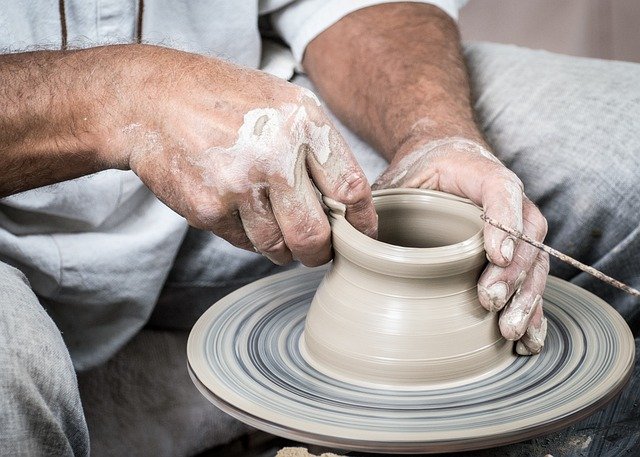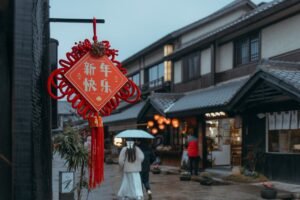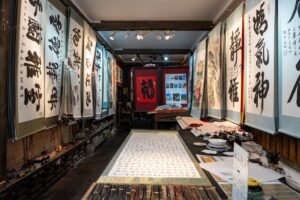Welcome to a fascinating journey into the world of Chinese traditional arts – a realm filled with breathtaking beauty, ancient traditions, and cultural richness. Have you ever wondered about the hidden stories that lie within the intricate brushstrokes of traditional Chinese paintings or the poetic elegance of calligraphy? Or perhaps you are curious about the mesmerizing sounds of traditional Chinese music or the graceful movements of classical dance forms? In this article, we will unravel the mysteries and enchantments of Chinese art forms, taking you on a captivating exploration of their historical significance and cultural heritage.
Table of Contents
ToggleKey Takeaways:
- Chinese traditional arts encompass a wide range of disciplines, including painting, calligraphy, music, dance, and crafts.
- Traditional Chinese painting combines skillful brushwork, vivid colors, and symbolic motifs.
- Chinese calligraphy expresses beauty through elegant brushstrokes and rhythmic patterns.
- Traditional Chinese music and dance reflect the country’s rich cultural traditions.
- Chinese traditional crafts and folk art highlight the ingenuity and craftsmanship of the Chinese people.
Introduction to Chinese Traditional Arts
Chinese traditional arts encompass a wide range of disciplines that have been cherished and perfected over centuries. These art forms, including painting, calligraphy, poetry, music, dance, and crafts, are an integral part of China’s cultural heritage. Each art form embodies the artistic traditions and values that have shaped Chinese society throughout history.
Chinese traditional arts are not just about creating beautiful expressions of creativity; they also serve as a means of preserving and transmitting cultural knowledge from one generation to the next. These art forms offer a glimpse into the rich tapestry of Chinese history, showcasing the country’s artistic achievements and the depth of its artistic traditions.
Let’s embark on a fascinating journey through the enchanting world of Chinese traditional arts and discover the profound significance they hold in both artistic and cultural realms.
Traditional Chinese Painting
Traditional Chinese painting is a highly respected art form that has been cherished for centuries. Known for its exquisite brushwork, vibrant colors, and symbolic motifs, this art style reflects the rich cultural heritage of China.
What sets traditional Chinese painting apart is its unique techniques and themes. Artists use special brushes, ink, and rice paper to create beautiful landscapes, figures, flowers, and birds. This art form emphasizes not realism but capturing the spirit and essence of the subject matter.
The traditional Chinese painting style is deeply rooted in Chinese artistic traditions and influences from Daoist and Confucian philosophies. It embodies the harmonious balance between nature and humanity, and the interconnectedness of all things.
In traditional Chinese painting, every brushstroke is deliberate and carries deeper meaning. It is not just about capturing the physical appearance but also expressing emotions, energy, and the artist’s state of mind.
Traditional Chinese paintings often include mountains, rivers, bamboo, flowers, and animals. These subjects hold symbolic meanings and represent various virtues and ideals in Chinese culture. For example, the pine tree symbolizes longevity, while the lotus flower represents purity and resilience.
To gain a deeper appreciation for traditional Chinese painting, let’s take a look at this table showcasing the key characteristics:
| Key Characteristics of Traditional Chinese Painting | Description |
|---|---|
| Brushwork | Artists use a variety of brush techniques to create different textures and strokes, ranging from delicate and controlled lines to bold and expressive strokes. |
| Color Palette | This art style often uses subtle colors and ink washes, with an emphasis on shades of black, white, and gray. Vibrant colors are sparingly used to highlight certain elements. |
| Simplicity | Traditional Chinese painting values simplicity and minimalism, leaving room for the viewer’s imagination and interpretation. It aims to capture the essence of the subject matter with few brushstrokes. |
| Symbolism | Each element in a traditional Chinese painting holds symbolic meaning, representing virtues, ideals, or states of mind. The arrangement of elements conveys harmony and balance. |
Traditional Chinese painting continues to inspire and captivate art enthusiasts worldwide, as it carries the spirit of Chinese artistic traditions and cultural heritage. Its enduring beauty and profound symbolism make it an integral part of the vibrant world of Chinese art forms.
Chinese Calligraphy and Poetry
Chinese calligraphy is considered the art of writing. It expresses beauty through elegant brushstrokes and rhythmic patterns. It is a highly regarded form of artistic expression that holds great significance in Chinese culture.
Calligraphy in China dates back thousands of years and has been cherished as one of the highest forms of art. The art form began as a practical means of communication but quickly evolved into a visual representation of aesthetic values. Chinese calligraphy is deeply rooted in Chinese artistic traditions and reflects the culture’s philosophy and spirit.
The art of Chinese calligraphy requires technical skill and embodies the artist’s inner thoughts and emotions. Each character is carefully crafted using a brush and ink, with strokes that vary in thickness, speed, and direction. The resulting composition is a harmonious blend of form, rhythm, and balance.
What sets Chinese calligraphy apart is its close connection to poetry. In fact, calligraphy and poetry are considered “sister arts” in traditional Chinese culture. Both of these art forms embrace similar principles of rhythm, harmony, and expressive elegance.
Throughout Chinese history, calligraphers were often poets themselves. They would inscribe famous poems or their own verses onto scrolls, creating a harmonious union of words and brushstrokes. Such calligraphic works became treasured pieces of art, celebrated for their beauty and profound meaning.
The Aesthetics of Chinese Calligraphy
Chinese calligraphy is admired for its aesthetics, which emphasize the balance of line, space, and form. The strokes are not merely written; they flow with purpose and intention. The artist must masterfully control the brush to create fluid and graceful movements. Each stroke represents a moment of concentration and meditation, resulting in a visual representation of the artist’s state of mind.
There are different calligraphy styles in Chinese art, each with its own unique characteristics. Some of the most famous styles include seal script, clerical script, regular script, running script, and cursive script. Each style brings a distinct flavor to the art form, creating a diverse and vibrant landscape of calligraphic expression.
Chinese calligraphy is not just a form of writing; it is a reflection of the artist’s soul, capturing the essence of their thoughts and emotions.
Appreciating Chinese Calligraphy
Appreciating Chinese calligraphy requires an understanding of its cultural and historical context. It is not solely about deciphering the characters but also immersing oneself in the art form’s beauty, rhythm, and symbolism.
To truly appreciate Chinese calligraphy, consider attending exhibitions or visiting museums that showcase renowned masterpieces. Observe the brushstrokes, examine the composition, and delve into the meanings behind the chosen texts.
Furthermore, learning about the artists behind the calligraphic works can enhance your understanding and appreciation. Famous calligraphers such as Wang Xizhi, Yan Zhenqing, and Su Shi have left a lasting impact on the art of calligraphy and continue to inspire contemporary practitioners.
Participating in calligraphy classes or workshops can also provide a hands-on experience and help develop an appreciation for the intricacies of the art form. By practicing calligraphy, you can gain a deeper understanding of the techniques, rhythms, and aesthetics involved.
Influence and Legacy
Chinese calligraphy has profoundly influenced various art forms, such as painting and typography. The brushwork and compositional elements found in calligraphy are often mirrored in traditional Chinese painting, creating a harmonious relationship between the two.
Furthermore, calligraphy continues to be an integral part of Chinese cultural life. It is frequently displayed in homes, temples, and public spaces, serving as a reminder of the country’s rich artistic traditions. Calligraphic works are also cherished gifts on special occasions, symbolizing respect, friendship, and good fortune.
As we delve into the world of Chinese calligraphy and its close connection to poetry, we gain a deeper understanding of the profound artistic traditions cherished by the Chinese people. These art forms not only captivate the senses but also provide insights into the cultural heritage and values of China.
Traditional Chinese Music and Dance
Traditional Chinese music and dance are captivating forms of artistic expression that reflect the country’s rich cultural traditions. For centuries, the melodic sounds of traditional Chinese instruments and the graceful movements of classical dance forms have been cherished. Immersed in history and deeply rooted in Chinese artistic traditions, these art forms offer a glimpse into China’s cultural heritage.
The Melodic Sounds of Traditional Chinese Music
Traditional Chinese music is characterized by its unique instrumentation, aesthetic principles, and distinct regional styles. Instruments such as the guzheng (a plucked zither), pipa (a four-stringed lute), and erhu (a two-stringed bowed instrument) create enchanting melodies that evoke a sense of nostalgia and serenity.
Traditional Chinese music is a symphony of emotions, capturing the essence of nature, human experiences, and the eternal Chinese spirit.
With a history spanning over thousands of years, traditional Chinese music encompasses various genres and styles, including court music, folk music, and opera. Each genre carries its own unique characteristics and serves as a window into the diverse cultural landscape of China.
The Graceful Movements of Classical Chinese Dance
Traditional Chinese dance is a captivating art form that combines elegant movements, intricate formations, and expressive storytelling. Rooted in ancient Chinese civilization, classical Chinese dance incorporates elements of martial arts, ballet, and folk dance to create a visually spectacular performance.
Classical Chinese dance movements are characterized by their fluidity, grace, and emphasis on conveying emotions. Dancers often wear vibrant costumes and utilize props such as long silk ribbons, fans, and swords to enhance their storytelling. Each movement is carefully choreographed to embody the essence of traditional Chinese culture and convey a profound sense of beauty and spirituality.
The Cultural Significance of Traditional Chinese Music and Dance
Traditional Chinese music and dance play a vital role in preserving Chinese art forms and cultural heritage. They reflect the values, beliefs, and customs of ancient Chinese civilization and serve as integral parts of festivals, ceremonies, and rituals. Furthermore, these art forms have influenced and inspired various art forms around the world.
Through the captivating sounds of traditional Chinese instruments and the mesmerizing movements of classical Chinese dance, audiences are transported to a vibrant world of cultural richness and artistic excellence. The immersive experience of traditional Chinese music and dance allows us to appreciate the beauty, depth, and timeless appeal of Chinese art forms.
| Traditional Chinese Music | Classical Chinese Dance |
|---|---|
| Enchanting melodies | Elegant and expressive movements |
| Unique instruments | Intricate formations |
| Regional styles and genres | Storytelling through dance |
| Preserves cultural heritage | Spiritual and symbolic meanings |
Chinese Traditional Crafts and Folk Art
Chinese traditional crafts and folk art epitomize the ingenuity and craftsmanship of the Chinese people. These art forms have been cherished and passed down through generations, preserving China’s cultural heritage. Explore the exquisite beauty of various traditional crafts that showcase the country’s rich artistic traditions.
Intricate Porcelain
Porcelain, also known as china, is one of the most iconic Chinese crafts. Its delicate and translucent nature, combined with intricate designs and vibrant colors, makes it a treasured art form globally. From delicately painted vases to intricately patterned tea sets, Chinese porcelain is truly a sight to behold.
Impeccable Jade Carvings
Jade holds a significant place in Chinese culture and is deeply associated with prosperity, longevity, and beauty. Skilled artisans carve jade into intricate sculptures, jewelry, and ornaments, showcasing the craftsmanship and talent that has been honed for centuries in China.
Masterful Paper Cutting
Chinese paper cutting, or jianzhi, is a traditional and popular folk art form. With precision and skill, artists create intricate designs by cutting paper with small scissors or a knife. These pieces often feature auspicious symbols, animals, or scenes from daily life, reflecting the rich cultural heritage of China.
Exquisite Embroidery
Chinese embroidery is renowned for its meticulous detail and vibrant colors. This art form involves stitching intricate patterns onto fabric, creating stunning pieces of art. From silk garments adorned with beautiful embroidery to delicate tapestries, Chinese embroidery is a testament to the artistry of Chinese craftsmen.
Other Traditional Crafts
In addition to porcelain, jade carvings, paper cutting, and embroidery, Chinese traditional crafts include a wide range of other art forms, such as lacquerware, wood carving, silverware, and bamboo weaving. Each craft has its unique charm and history, contributing to China’s diverse artistic traditions.
Discover the Beauty, the Skills, and Heritage
| Traditional Craft | Description |
|---|---|
| Porcelain | Delicate and translucent ceramic art with intricate designs and vibrant colors |
| Jade Carvings | Carved sculptures, jewelry, and ornaments made from beautiful jade stone |
| Paper Cutting | Intricate designs are created by cutting paper with small scissors or a knife |
| Embroidery | Meticulously stitched patterns on fabric, showcasing vibrant colors and detailed designs |
| Lacquerware | Artistic objects coated with layers of refined lacquer, often decorated with intricate designs |
| Wood Carving | Intricate carvings on wood, showcasing the skill and craftsmanship of Chinese artisans |
| Silverware | Exquisite silver objects, including jewelry and utensils, crafted with precision |
| Bamboo Weaving | Handcrafted items made from flexible bamboo, ranging from baskets to furniture |
Chinese traditional crafts and folk art are not only visually captivating but also hold a significant place in the country’s cultural heritage. They represent the country’s artistic traditions, creativity, and love for craftsmanship. Exploring these art forms offers a glimpse into the rich tapestry of Chinese culture and history.
The Historical Significance of Chinese Traditional Arts
To truly appreciate the beauty and depth of Chinese traditional arts, it is crucial to delve into their historical context. The art forms that have emerged from Chinese culture over centuries hold immense historical significance and have left a lasting impact on the country’s cultural identity.
The roots of Chinese art history can be traced back thousands of years, with the earliest known examples dating back to the Neolithic period. These ancient artifacts provide insight into the early artistic traditions of China and the artistic techniques that would later develop into more refined forms.
Throughout the centuries, Chinese artistic traditions evolved and were influenced by various dynasties and cultural movements, each leaving behind its own distinctive imprint. From the Tang Dynasty’s golden age of poetry and painting to the Song Dynasty’s refinement of ink-wash painting, each era contributed to the rich tapestry of Chinese art history.
Chinese traditional arts not only reflect the artistic skills of their creators but also embody the values, beliefs, and aesthetics of the Chinese people. They serve as a visual representation of the cultural heritage of China, encapsulating the nation’s history, philosophies, and societal norms.
One of the most prominent examples of Chinese art history is traditional Chinese painting, which has been perfected over centuries. Its techniques, such as meticulous brushwork and symbolic motifs, are deeply ingrained in Chinese artistic traditions. These paintings often depict scenes from nature, historical events, or everyday life, showcasing the beauty and harmony that Chinese culture reveres.
Another integral part of Chinese art history is calligraphy, which is not merely a form of writing but an art in its own right. Chinese calligraphy, characterized by its intricate brushstrokes and rhythmic patterns, has long been revered as a visual expression of beauty and elegance. Often intertwined with poetry, calligraphy represents the profound influence of literature and language in Chinese culture.
| Art Form | Key Highlights |
|---|---|
| Traditional Chinese Painting | – Meticulous brushwork and vivid colors – Depiction of nature, history, and everyday life – Symbolic motifs reflecting Chinese cultural values |
| Chinese Calligraphy | – Elegant brushstrokes and rhythmic patterns – Integration with poetry and literature – Revered as an expression of beauty and grace |
Chinese traditional arts are not only a testament to the past’s artistic achievements but also play a significant role in shaping contemporary Chinese cultural identity. Today, these art forms continue to be celebrated and embraced, serving as a bridge connecting the present with China’s rich cultural heritage.
Preserving and Promoting Chinese Traditional Arts: The Role of LC Chinese School
LC Chinese School is committed to preserving and promoting Chinese traditional arts. It plays a vital role in educating students and cultivating a deeper appreciation for China’s cultural heritage. Through its comprehensive curriculum and cultural programs, LC Chinese School provides students with a unique opportunity to learn and engage with various Chinese art forms.
At LC Chinese School, students are immersed in the beauty and significance of Chinese art forms, including traditional painting, calligraphy, music, dance, and crafts. Through hands-on instruction, expert guidance, and a supportive learning environment, students gain a holistic understanding of the historical and cultural context surrounding these art forms. They also develop the skills and techniques necessary to express themselves creatively and authentically.
One way LC Chinese School fosters a deeper connection to Chinese traditional arts is through Chinese language courses, cultural programs, and events. These initiatives allow students to showcase their talents and share their appreciation for Chinese art forms with the wider community. Whether through exhibitions, performances, or collaborative projects, students are encouraged to express their creativity and develop a sense of pride in their cultural heritage.
“LC Chinese School has been instrumental in preserving and promoting Chinese traditional arts in our community. The school’s commitment to educating students in the Chinese language and culture and fostering a greater understanding of our cultural heritage is truly commendable.” – Lisa, Parent
By preserving and promoting Chinese traditional arts, LC Chinese School contributes to the wider cultural landscape, ensuring the continuity and appreciation of these art forms for future generations. Students who participate in LC Chinese School not only develop artistic skills but also gain a deeper understanding and respect for Chinese artistic traditions.
| Benefits of LC Chinese School’s Programs: | LC Chinese School’s Impact on Cultural Heritage: |
|---|---|
| 1. Introduction to a wide range of Chinese art forms | 1. Preservation and promotion of Chinese cultural heritage |
| 2. Hands-on instruction and guidance from experienced artists | 2. Fostering a deeper appreciation for Chinese artistic traditions |
| 3. Opportunities to showcase talents through exhibitions and performances | 3. Cultivating a sense of pride in cultural heritage among students |
| 4. In-depth understanding of the historical and cultural context of Chinese traditional arts | 4. Contributing to the wider cultural landscape and artistic community |
Through its dedication to preserving and promoting Chinese traditional arts, LC Chinese School serves as a beacon of cultural heritage, enriching the lives of students and the community at large. By imparting the knowledge and appreciation of Chinese art forms, LC Chinese School ensures the continuation of these timeless traditions for generations to come.
Conclusion
Chinese traditional arts provide a glimpse into the cultural heritage and artistic traditions of China. From the mesmerizing strokes of traditional painting to the lyrical beauty of calligraphy and the graceful movements of dance, these art forms captivate audiences around the world. Through exploring and preserving these art forms, we not only celebrate China’s cultural legacy but also ensure that future generations can appreciate and honor this rich cultural heritage.
Chinese traditional arts reflect the essence of Chinese culture and history. They carry the stories, values, and beliefs of the Chinese people, showcasing their creativity, skill, and deep connection to their roots. By appreciating and supporting these art forms, we contribute to the preservation and promotion of the diverse artistic traditions that have shaped China’s cultural identity.
As we continue to embrace the beauty and significance of Chinese traditional arts, it is crucial to recognize the efforts of institutions like LC Chinese School. Through their dedication to education and cultural programs, LC Chinese School plays a vital role in nurturing the next generation of artists and fostering a deeper appreciation for Chinese art forms. By supporting these initiatives, we can ensure that Chinese traditional arts thrive and continue to enrich our lives.
FAQ
What are Chinese traditional arts?
Chinese traditional arts encompass a wide range of disciplines, including painting, calligraphy, poetry, music, dance, and crafts. These art forms have a long history and play a significant role in Chinese culture.
What is the historical significance of Chinese traditional arts?
Chinese traditional arts hold a deep historical significance. They offer insights into the development of Chinese art forms and their impact on cultural identity. Understanding the historical context helps us appreciate the evolution and lasting influence of these art forms.
What is traditional Chinese painting?
Traditional Chinese painting is an esteemed art form that combines skillful brushwork, vivid colors, and symbolic motifs. It has a profound influence on Chinese culture and is known for its unique techniques and themes.
What is Chinese calligraphy?
Chinese calligraphy is the art of writing, expressing beauty through elegant brushstrokes and rhythmic patterns. It is closely related to poetry and has been highly regarded throughout Chinese history.
What are traditional Chinese music and dance?
Traditional Chinese music and dance are captivating forms of artistic expression that reflect the country’s rich cultural heritage. They showcase melodic sounds produced by traditional instruments and graceful movements in classical dance forms.
What are Chinese traditional crafts and folk art?
Chinese traditional crafts and folk art demonstrate the ingenuity and craftsmanship of the Chinese people. They encompass various forms of artistry, including porcelain, jade carvings, paper cutting, embroidery, and more.
How does LC Chinese School contribute to preserving and promoting Chinese traditional arts?
LC Chinese School plays a crucial role in preserving and promoting Chinese traditional arts through its comprehensive curriculum and cultural programs. The school educates students and fosters a deeper appreciation of Chinese cultural heritage.
Why is it important to preserve Chinese traditional arts?
Preserving traditional Chinese arts allows us to celebrate and honor China’s cultural heritage. These art forms offer a glimpse into the country’s rich history and cultural tapestry, ensuring they are passed on to future generations.








